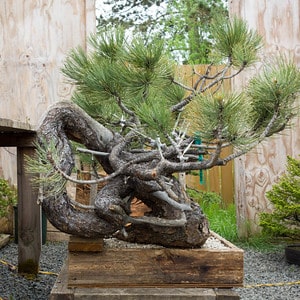On a recent tour to Oregon, Eric Schrader and I had the opportunity to visit Michael Hagedorn’s garden. It was quite a treat. The garden is filled with trees on the fast path to becoming awesome bonsai. Collected material – many from the Pacific Northwest – and deciduous varieties like chojubai fill many of the benches. Long-term grafting projects and novel containers are commonplace here, as are trees that look like they’ve come straight from exhibit.
Those who follow Michael’s work on crataegus.com or via Facebook will be familiar with his collection. Michael has done a great job cataloging his work in an effort to share the knowledge he’s gleaned from his bonsai adventures at home and abroad.
For those unfamiliar with Michael’s work, I’ve provided links to articles relating to some of the trees pictured below, each offering insight into the process that helped these trees take shape.

Michael Hagedorn with his giant mountain hemlock

Hemlock – more at Very Large Mountain Hemlock Clump

Rocky Mountain juniper – see the repotting

Grafted Rocky Mountain juniper – here’s the story

Rocky Mountain juniper, aka The Fish
Michael styled the Western juniper below in 2009 for Bonsai Focus. I happened to be around that day and was impressed to see how quickly the tree took shape. Here’s an overview of the article, A Cascading Juniper Created by Michael Hagedorn.

Western juniper

Rocky Mountain juniper

Needle juniper
I’m also familiar with the progress the Japanese maple below has made over the years – it’s a beautiful specimen.

Japanese maple – more at Japanese Maple Year 2

Red maple

Stewartia
Michael’s fascination with alternative supports finds a wonderful exemplar in the vine maple below.

Vine maple – see the composition take shape
Michael has built a great case for the promotion of chojubai bonsai over the years, and his garden reflects this.

Chojubai

Chojubai

Chojubai

Chojubai

Chojubai
Read Michael’s Chojubai Notes for display and care tips.

Ponderosa pine – see how the tree got its start

Ponderosa pine

Black pine grafted on Ponderosa – this tree has undergone a significant transformation
I was very happy to see a couple of black pines I started in 1999 are still in Michael’s collection. Here’s one of them:

Black pine

Black pine
And for another example of a tree that’s come a long way in a short time, compare the results from Englemann Spruce Styling with the photo below.

Englemann spruce
Before leaving Michael’s garden, I’d recommend that anyone who’s serious about bonsai read his book, Post Dated: The Schooling of an Irreverent Bonsai Monk (read the review). It’s a fun read that offers insight into the apprentice experience drawn from Michael’s experience studying with Shinji Suzuki in Obuse, Japan. Pick it up, give it a read, and let us know what you think.
Subscribe to Bonsai Tonight
New Posts Delivered Every Tuesday and Friday
Bruce Winter says
Always a pleasure and inspiring to see what Michael’s been up to.